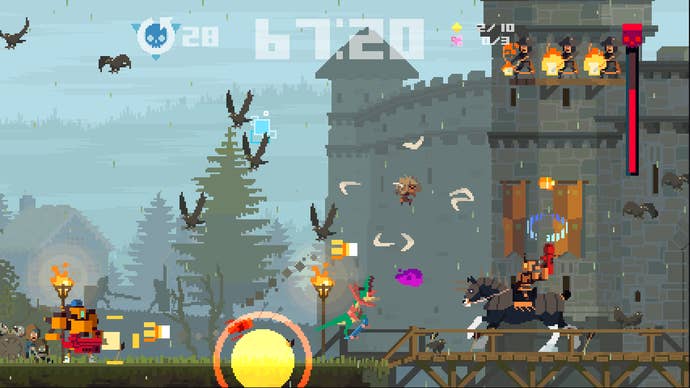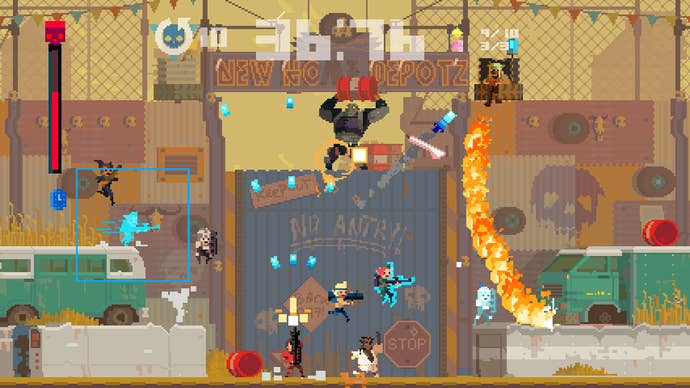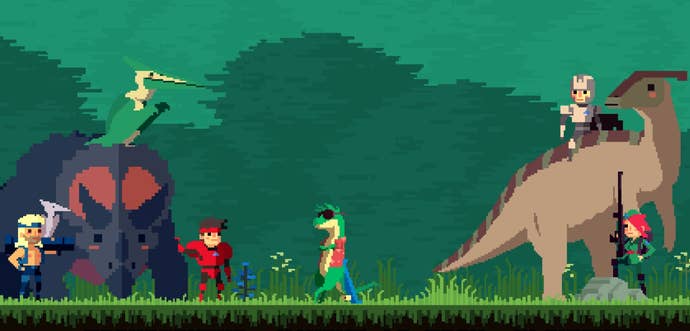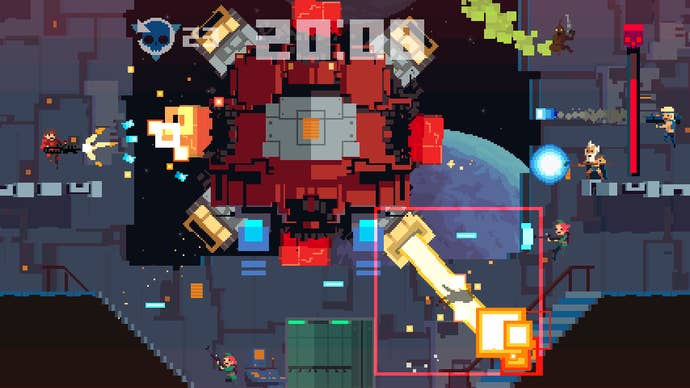Super TIME Force Xbox One Review: Better Than an Acid Flashback
Capybara's recursive action shooter bends time in new and interesting ways, but....
This article first appeared on USgamer, a partner publication of VG247. Some content, such as this article, has been migrated to VG247 for posterity after USgamer's closure - but it has not been edited or further vetted by the VG247 team.
Primary Reviewer, Jeremy Parish
I suppose it's only fitting that as I played Super T.I.M.E. Force, a game that revolves around rewinding time in order to change events and outcomes, I kept finding myself wishing I could jump backward in time myself. Specifically, I wanted to go back and revisit the original version of the game Capybara was showing off a few years ago.
I like the current, final rendition of the game just fine, mind you – it's hardly chopped liver. But STF has grown into a very different creature than the Contra-style platform shooter that it started out to be. What once was a breezy action game with a fun time travel hook has become a much denser, more puzzle-like creation. While I can see a lot of the same ideas that made the older rendition of the game so entertaining (such as turning time back to prevent an ally's death and gaining a bonus for your feat), they've changed considerably over the course of the game's evolution.

Weirdly enough, I'm also disappointed that I'll never see the resolution of that old demo's cliffhanger ending. There, you destroyed the cataclysmic meteor that was supposed to wipe out the dinosaurs, and upon returning to the present day you discovered that dinosaurs now ruled the world and had outlawed humans. It was an amusing concept that the final release sadly doesn't explore. While you still blast your way through prehistory, causality takes a backseat to nonlinearity. You'll save the dinosaurs (and possibly recruit one for your team), but STF's Mega Man-like approach to stage selections means that once you return to the present, nothing much changes no matter what order you play the levels in.
So, I feel conflicted. Games change in development all the time, of course. And Capybara's sweeping revisions to STF have definitely made for a deeper, more unique creation. But I was so smitten with that early version, which pushed all the right buttons for me, that its having been subsumed by something different left me longing for a game that will never exist.
Fundamentally, STF plays the same as ever: You control a team of soldiers, one at a time, each capable of wielding different weapons (and in a few cases, no weapon at all). When one character dies, the game freezes and enters a rewind mode that allows you to cycle back through the action and restart at any point back to the beginning of the stage to try different tactics with a different soldier (or the same one, if need be). If you can change the sequence of events that downed your comrade – say, block a deadly projectile or take down the enemy that fired it before the projectile is unleashed – the newly undead character won't die. Instead, they become available to join your team and boost your firepower. Meanwhile, every "life" you play remains active, repeating its actions, no matter how many times you loop back through time to try again.

This unconventional, overlapping style opens up a ton of different strategies. For example, the character Shieldy McBlockerton doesn't carry a weapon; he totes a shield. But while he's difficult to use on his own, if you manage to use his defensive techniques to save an otherwise doomed character, his defensive actions become supplemented by the new tagalong's gunfire. Likewise, powerful short-range characters make great backup for combatants whose weak guns require charging for maximum effect and tend to go down quickly in close quarters. Mixing and matching the game's remarkable cast of protagonists creates a ludicrous amount of potential strategy, and you'll constantly find yourself surprised and impressed by the tricks you can pull off.
Despite this, though, STF's rewind feature proves to be hit or miss. The difference generally comes down to a matter of level design. The more linear stages don't offer many opportunities for clever time-travel shenanigans, while those with more convoluted layouts reward the ingenious.
STF's defining feature is time, and nowhere is that more evident than the incredibly harsh time limits under which you have to complete each level. The further back you rewind, the more time you can shave off your performance. In its best moments, STF demands temporal multitasking: Completing one mission objective then rewinding to perform a different task. Disappointingly, this is only strictly mandatory in the final stage, and the fact that it shows up so late feels like a missed opportunity.
I suppose that's really the crux of my ambivalence of about STF — not that its design changed so much from those wonderful early iterations, but that it didn't change quite enough. Rewinding time to make use of a team full of differently skilled soldiers opens the door for boundless creative possibilities, but the game's origins as a more straightforward shooter still show through and keep the action from being as complex and intricate as it truly begs to be.

And when it works, STF is brilliant; the boss battles in particular (in which it's impossible to collect the time extension pickups that mitigate the 60-second countdown in normal levels) truly make the most of the rewind feature as well as your entire suite of characters. Because boss battles take place in a small arena and involve a fixed time limit, you can do ridiculous things. For instance, you can have Shieldy stand in the spots where a boss' attacks will be focused and spam his shield powers, rewind, and repeat in different spots until you've created multiple safe havens for your heavy gunners to stand and pour bullets at the boss.
The attacks of previous combatants remain active no matter how many times you rewind, so eventually, with enough recursion, you can fill the entire screen with projectiles and win through sheer force. And if you manage to shorten the phases of multi-stage bosses, the later actions of rewound heroes have a different impact in the dynamic fight than they did at first.
There's so much potential here, yet STF ends right as it starts to come into its own. It feels very much like a game caught between its run-and-gun origins and its more intricate ambitions; the straightforward level design just doesn't offer a sufficiently devious playground for the complex interplay and capabilities afforded by the time travel mechanics.
Second Opinion, Mike Williams
I remember playing Super TIME Force for the first time at PAX East 2012. After my short demo, I turned to the Capybara developer at the booth and asked, "When is this coming out?" He shrugged and said the demo was just a side project and the studio had no planned release date. Every PAX event since then, I've played the newest demo and asked when the game was coming.
My patience has been rewarded.

Super TIME Force is great, even if it's not the Contra or Gunstar Heroes-style shooter you'd expect from the screenshots. With great reflexes alone, you can probably race though many of the levels in the game - after a tutorial and opening level, you get to choose which other time periods you want to pillage and destroy - but Super TIME Force requires different thinking at certain points, especially during the boss fights.
See, when you first start playing you'll think in short loops, using time jumps to save yourself from recent deaths or grab out of the way collectibles. Eventually, you'll start to realize that you're not constrained by recent events. When you loop, you can return all the way to the beginning of the run if you so desired. Once you understand that, you'll begin to think long-term, setting up bigger and more complex loops to complete tasks. Much like another title that required you to "think with portals", Super TIME Force prizes your mind as much as it prizes your reflexes.
That's not to say your reflexes aren't along for the party. You can and will need to dodge and shoot if you want to save your time loops (you begin each level with 30) for things other than preventing deaths. It's not Gunstar Heroes or Contra: Hard Corps hard, but it will provide a bit of challenge for players.
There's also the amazing cast, including a number of unlockable characters. You'll begin Super TIME Force with the machine-gun toting Jean Rambois, team sniper Aimy McKillin, and defensive member Shieldy Blockerson, under the command of the hardcore, double eyepatch-sporting Commander Repeatski. Along the way, you unlock characters like Jef Leppard, Dolphin Lundgren, Zakasaurus, and Melanie Gibson. The entire cast and most of the levels are full of pop culture references. Super TIME Force feels like a giant wink and nod to 80s and 90s action films, like a more light-hearted Far Cry 3 Blood Dragon.

If I had any problem with Super TIME Force, it's that the game is rather short and needs more levels to let players really explore what you can do with time loops. Either a sequel or a level editor would go a long way to letting the concept live on for years and years to come. Yeah, my only real compliant is I want more. It's great game and when the mechanics, the levels, and your ideas come together, it's pretty damn amazing.
The Breakdown:
- Graphics: Retro for a reason — the screen gets overwhelmingly full in a hurry once you start overlapping timelines. Despite the graphics' simplicity, they have a load of charm.
- Audio: Deliberately dated, like the visuals, though less for functional reasons than stylistic.
- Interface: Simple and straightforward, offering an enticing entryway for a heady, complicated concept.
- Lasting Appeal: Plenty of hidden collectibles and secrets and alternate modes to foster longevity, even if the fairly straightforward level designs don't offer too many surprises after your first run.
ConclusionCapybara has designed a devastatingly complex game that manages to feel wholly intuitive and approachable in practice; I just wish it explored more of its potential. If ever a game begged for a sequel to fully realize a great concept, Super T.I.M.E. Force is it.








